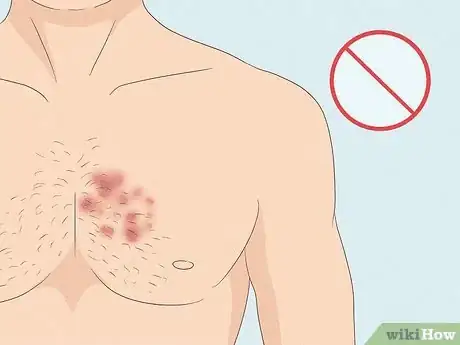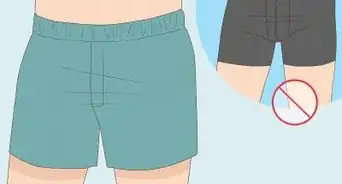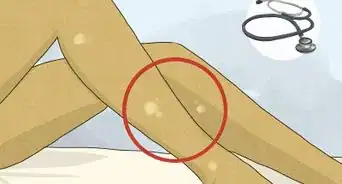This article was co-authored by Melissa Jannes and by wikiHow staff writer, Eric McClure. Melissa Jannes is a Licensed Esthetician and the owner of Maebee's Beauty Studio in Philadelphia, a single practitioner space providing quality services with individualized attention. Melissa is also a National Educator for Universal Companies. She received her esthetics degree at The Beauty School of Middletown in 2008 and is licensed in both New York and Pennsylvania. Melissa won the "Best of Beauty" award from Allure magazine in 2012 for the quality of her bikini waxing.
There are 8 references cited in this article, which can be found at the bottom of the page.
This article has been viewed 2,318 times.
Hard waxing is a hair removal process similar to soft waxing—a wax goes on your skin and then it’s pulled off to rip the hairs out by the roots. Unlike soft wax, hard wax literally hardens before it is peeled off. If you’ve never experienced hard wax before, you may be worried about how the prep differs from soft wax. The good news is that hard wax is actually much easier on your skin, and you may never want to go back to soft wax again! In terms of prep, your goal here is to wax healthy, clean skin. If you’re curious about how to do this, we’ve got you covered!
Steps
Weeks before Your Wax
-
1Let your hair grow out so it’s at least 1⁄4 in (0.64 cm) long. Just like soft wax, the hard wax won’t be able to cure your hair if isn’t long enough. Let whatever hair you plan on waxing grow out for at least two weeks or so leading up to your waxing session.[1] The longer it is the better, but it should be fine so long as your hair is at least 1⁄4 inch (0.64 cm) in length.[2]
- Hard wax actually requires less hair than soft wax for the procedure to work, but it’s still best to grow your hair out just to make things easier for the esthetician.
-
2Keep moisturizing your skin and drink plenty of water. Don’t dramatically change your skincare routine in the weeks leading up to the waxing. Continue moisturizing your skin regularly so that it stays hydrated and healthy, and drink plenty of water in the weeks leading up to your appointment.[3]
- Waxing dried-out skin is going to be more painful, but there’s a bigger reason to stay hydrated and healthy. When you wax, the goal is to remove hair from the root, but dried-out skin leads to dried-out hair. If you wax dried-out hair, it may break and leave a portion of the hair in the root.
Advertisement -
3Protect your skin from the sun and don’t go tanning. The less damage your skin goes through, the easier it will be for the wax to completely remove your hair. If you’re going to spend more than a few minutes outside, wear sunscreen. Take a break from the tanning bed if you use one. You can pick the tanning routine up after you’re done with your appointment.[4]
- Aside from the fact that excess sun can dry your skin out, it can also cause sunburn. Sunburned skin is going to hurt to wax, and you may not be able to go through with the procedure if it’s especially bad.
Days before Your Waxing Session
-
1Exfoliate your skin with a dry brush in the shower.[5] You can use another method if you prefer, but dry brushing is the ideal prep for hard wax. Before you shower, grab your brush and move it back and forth along the skin you’re going to wax. This will clean your skin thoroughly and remove any dead skin cells that are caked into your pores.[6]
- Do this multiple times before your waxing session. It will be a lot easier for the wax to pull hairs out by the root if there aren’t any blockages or dead skin cells clogging your pores.
-
2Reschedule your waxing plans if you have any outbreaks or damaged skin. You cannot wax your skin if there are any pimple outbreaks, broken skin, scabs, or lesions. Even if you repair the skin in time, the chemicals in retinoids, Accutane, and other healing agents you’d use will make your skin especially sensitive to the wax, so just wait for your skin to heal.[7]
- You want your skin to be as healthy as possible. It’s totally fine if you have a small blemish that isn’t causing you pain, but the stronger and healthier your skin is, the better.
- If it’s just a tiny patch of skin and you want to wax around it, you can cover the damaged skin up with a bandage.
-
3Continue to moisturize your skin up until the day before the appointment. Keep your skin healthy by continuing to moisturize the same way you normally do. The day before your appointment, stop moisturizing. You want your skin to be totally clean and clear in the 24 hours leading up to your appointment.[8]
- Hard wax is going to harden against your skin when it is applied. If there’s a bunch of moisturizer worked into your skin and keeping it super soft, it may be more difficult for the wax to cure.
Morning of Your Waxing Session
-
1Take an OTC pain reliever ahead of time if necessary. If you’re especially sensitive to pain from waxing or you’ve never done it before, take an OTC pain medication, like ibuprofen or aspirin, at least 1 hour before you get your skin waxed. While hard wax is way less painful than soft wax, it may still hurt. Taking a pain reliever preemptively should really help take the edge off.[9]
- If you’ve ever had a soft wax, take a deep breath. Hard wax should hurt way less than your previous experiences.
-
2Hop in the shower before you wax your skin.[10] Not only will you feel better if your skin is clean, but a warm shower will help to open up your pores. You can even take a bath if you feel like soaking for a while! Don’t overdo it with the soap or scrubs, though. You just want super clean skin.[11]
- Dry your skin by patting it dry with a clean towel.
-
3Don’t use any skin products and wear comfortable clothes. Skip the moisturizer and makeup when you get out of the shower. Wax works best on 100% clean skin. Your skin may be a little sensitive after you get waxed, so dress for comfort, not style. When in doubt, stick with loose-fitting cotton clothing.[12]
- Your esthetician may perform some other prep if you have an appointment, so don’t worry that you’re underprepared or anything like that. It's easy to go into this feeling like you're not ready, but you'll be fine!
Community Q&A
-
QuestionHow do you prep your bikini area for waxing?
 Melissa JannesMelissa Jannes is a Licensed Esthetician and the owner of Maebee's Beauty Studio in Philadelphia, a single practitioner space providing quality services with individualized attention. Melissa is also a National Educator for Universal Companies. She received her esthetics degree at The Beauty School of Middletown in 2008 and is licensed in both New York and Pennsylvania. Melissa won the "Best of Beauty" award from Allure magazine in 2012 for the quality of her bikini waxing.
Melissa JannesMelissa Jannes is a Licensed Esthetician and the owner of Maebee's Beauty Studio in Philadelphia, a single practitioner space providing quality services with individualized attention. Melissa is also a National Educator for Universal Companies. She received her esthetics degree at The Beauty School of Middletown in 2008 and is licensed in both New York and Pennsylvania. Melissa won the "Best of Beauty" award from Allure magazine in 2012 for the quality of her bikini waxing.
Licensed Esthetician & Brazilian Wax Educator Stop shaving at the very minimum of two weeks before your waxing session. That ensures that the wax will be very thorough. When the hair is a bit longer, it's easier to get it out cleaner. You should be exfoliating a few times a week to prevent ingrown.
Stop shaving at the very minimum of two weeks before your waxing session. That ensures that the wax will be very thorough. When the hair is a bit longer, it's easier to get it out cleaner. You should be exfoliating a few times a week to prevent ingrown.
References
- ↑ Melissa Jannes. Licensed Esthetician & Brazilian Wax Educator. Expert Interview. 30 August 2019.
- ↑ https://www.goodhousekeeping.com/beauty/anti-aging/a32818/bikini-wax-tips/
- ↑ https://www.self.com/story/at-home-waxing-tips
- ↑ https://www.waxdowntownphila.com/read-me
- ↑ Melissa Jannes. Licensed Esthetician & Brazilian Wax Educator. Expert Interview. 30 August 2019.
- ↑ https://fashionmagazine.com/beauty-grooming/leg-waxing-tips/
- ↑ https://www.healthshots.com/beauty/skin-care/should-you-or-shouldnt-you-wax-your-face-that-is-the-question-and-we-answer-it-here/
- ↑ https://www.flare.com/fashion-beauty/how-to-give-yourself-a-wax-at-home/
- ↑ https://www.self.com/story/how-to-take-the-pain-out-of-wa
- ↑ Melissa Jannes. Licensed Esthetician & Brazilian Wax Educator. Expert Interview. 30 August 2019.
- ↑ https://www.goodhousekeeping.com/beauty/anti-aging/a32818/bikini-wax-tips/
- ↑ https://www.flare.com/fashion-beauty/how-to-give-yourself-a-wax-at-home/





























































